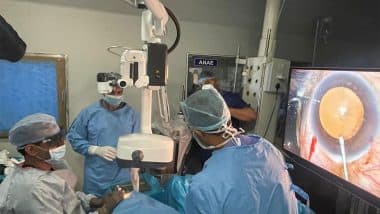New Delhi [India], April 26 (ANI): The Army Hospital (Research and Referral) is the apex flagship medical care centre for the Indian Armed Forces and is set to embark on a significant expansion with the latest technologies, including a 3-D Microscope for eye surgeries.
The Department of Ophthalmology is being credited with performing the minimally invasive glaucoma surgery (MIGS) for glaucoma patients using a 3-D Microscope, for the first time in the country, a unique milestone for the Armed Forces.
Also Read | Bihar Shocker: Man Arrested for Raping 6-Year-Old Girl in Vaishali When She Was on Her Way to Buy Biscuits.
This three-dimensional visualisation system is very useful for eye surgeries, including squint surgery, cataract surgery, corneal surgeries, glaucoma surgery, and retinal surgeries. This system utilises special polarised 3D polarisation glasses and a 55-inch 4K ultra-HD display.
Potential advantages include significantly lesser surgical time/complication rate compared to a conventional microscope, decreased power of endoilluminator, reduced phototoxicity, ease of use in uncommon and complicated situations including severe kyphosis, reduced need for triamcinolone staining of the vitreous, and high surgeon and nurse satisfaction scores.
Brigadier Sanjay Mishra, a distinguished ophthalmic surgeon and Head of Department, Department of Ophthalmology, Army Hospital, Research and Referral, New Delhi, states that the 'introduction of this latest gadget into an Ophthalmic arena could only be possible in future under the esteemed patronage of DGAFMS Surg Vice Admiral Arti Sarin. It is her motivation that prompted us to use 3-D microscopes in ocular surgeries at the Apex Armed Forces Institute.
In addition, three-dimensional display systems are showing ever more promising results in the field of ophthalmology, both for anterior and posterior segment surgeons. Heads-up surgery using 3D display screens has been increasingly accepted due to its advantages in terms of ergonomics and surgical teaching/coordination. The use of head-mounted display systems is a novel emerging concept in ophthalmology.'
Moreover, we have experienced great image quality, great depth perception and spatial orientation, as also reiterated by the ophthalmic assistant. This initiative is a testament to the unwavering commitment of the Indian Army to ensuring top-tier medical services reach our clientele at the apex institutes. (ANI)
(This is an unedited and auto-generated story from Syndicated News feed, LatestLY Staff may not have modified or edited the content body)













 Quickly
Quickly













